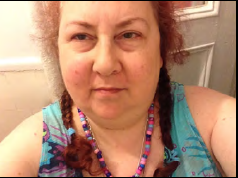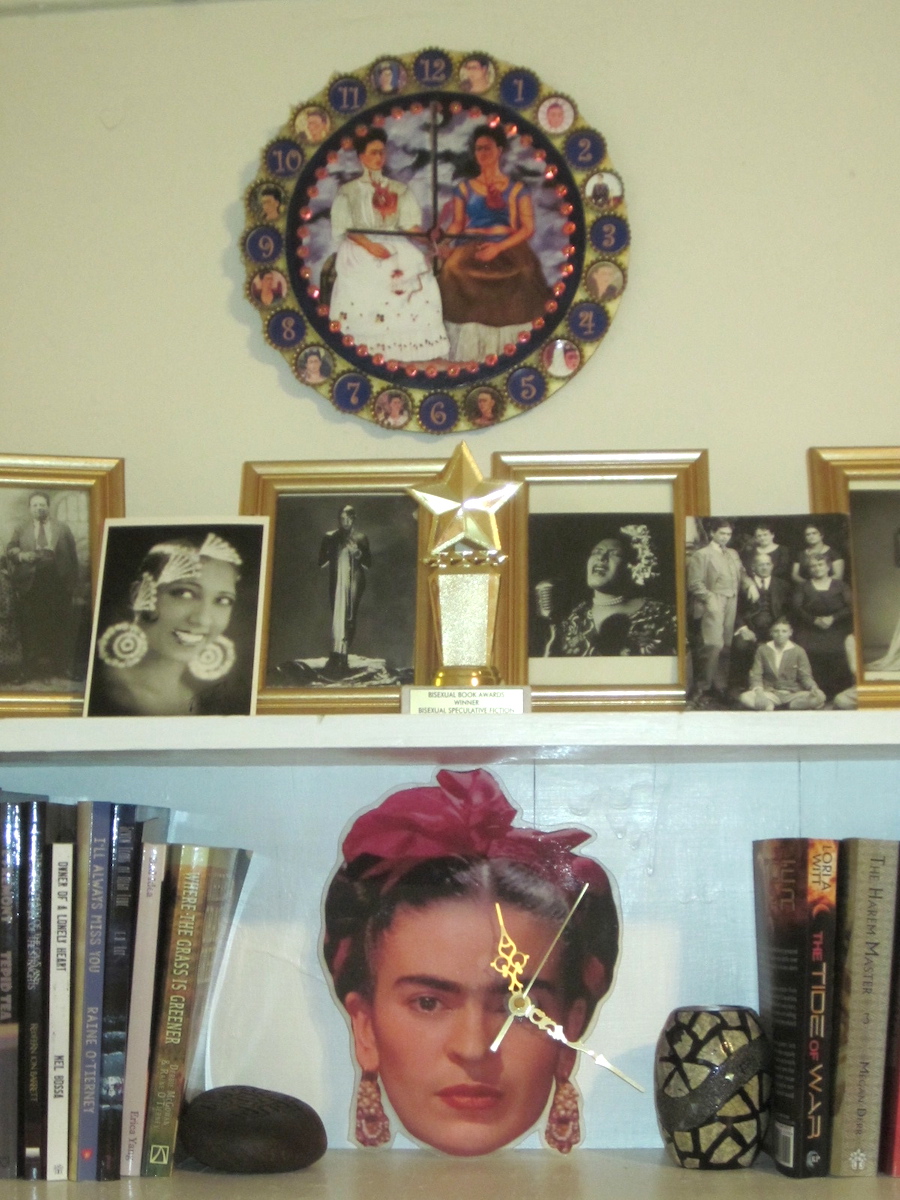By Sheela Lambert
When I think of bi+ role models and bicons, the person who most comes to mind is Frida Kahlo. Frida Kahlo was a famous Mexican artist who was married to the famous Mexican muralist and painter, Diego Rivera. When they married, he was a titan, but although he is still famous, Frida has the heart of Mexico and of people from all over the world. I’m not sure why I connect with her so strongly, more than any other bicon, but I have her images, books, and paintings all over my house. I’ve read the main biography about Kahlo by Hayden Herrera 10 times, seen the movie version (starring Salma Hayek) at least six times, and have already read the latest biography about her, Frida in America by Celia Stahr, published in 2020, from front to back.
Kahlo’s art was very personal and, due to health problems that often kept her confined to her house or to bed (a lifestyle I recognize as my own), she frequently had to be her own model. It is remarkable how mesmerizing her self-portraits are. Each one grabs your attention, whether through the depth and intensity of her stare, her unibrow (which in many self-portraits looks like a bird winging away), or the exotic menagerie of animals on her shoulders. Unlike most women, she didn’t pluck her eyebrows or shave her mustache to feminize herself: she exaggerated her masculine features. At 18, she showed up to the annual family portrait dressed in a man’s three-piece suit, with her hair slicked back. She later reprised this look in a painting, after she discovered that Diego was having an affair with her sister and best friend, Cristina. In Self-Portrait with Cropped Hair, she is once again dressed in a men’s suit, locks of her hair surrounding her on the ground—looking like pieces of twisted roots. She sits on a wooden chair, holding the scissors that did the deed: a message to her husband who loved her long hair, and a symbol of grief that both he and her sister betrayed her.
Frida was not afraid to portray herself looking butch, which may have been a beacon to bisexual and lesbian women, that she could be open to their overtures or make some of her own. One of her lovers was Chavela Vargas, a Mexican resident and butch lesbian who toured the world as a singer. She sang many ranchera songs, traditionally sung by men, but didn’t change the pronouns, so she was often singing love songs to women. She also slowed down the pace of the songs, which made them more moving. Vargas appeared in the Frida movie as an old woman wrapped in a shawl, signaled to be a ghost, sitting in a dark corner of Frida’s local bar. She pulls back the shawl, revealing her craggy, masculine face and very short hair, then begins to sing a slow, poignant song.
What Frida and I have most in common are bisexuality, chronic illness, and turning to the arts when disability hit—she because of polio and the results of a fateful bus and trolley accident; me because of Crohn’s disease, IBS, chronic fatigue syndrome, neuropathy, back problems, and edema. When Crohn’s started, it reactivated and/or sprouted the others. Frida’s painting of The Wounded Deer, showing a deer alone in a forest with the androgyny of Frida’s female face but male deer antlers, her body bristling with bloody arrows, makes visual the physical and emotional pain she feels. Kahlo’s choice to represent herself as a deer was not a random one. She had a pet deer, Granizo, whom she adopted as a tiny fawn, so the choice of a deer to represent herself was a personal one, and to make the Frida deer appear androgynous, an even more personal one. The legacy of her accident and childhood polio meant lifelong pain, surgeries, body-casts, and foot and leg problems which immobilized her at worst and made walking difficult and painful at best: she could only walk a few blocks on a good day and one on a bad day. I’m the same way due to neuropathy and chronic fatigue. For years, the pain of Crohn’s disease felt like a large kitchen knife that no one else could see, stabbing me in the stomach, so the Frida deer, stabbed with nine arrows, really resonates with me. She is making visible her invisible pain. That was my life for years. Just substitute the Frida face from the deer with my own. Invisible disabilities can be just as painful as visible ones, as her painting makes clear. She has several other paintings that speak to the physical suffering and pain she endured, such as The Broken Column and Henry Ford Hospital.
Frida was also fairly open about her bisexuality, and several of her paintings reflect that, such as Self-Portrait with Cropped Hair, mentioned before. The Two Fridas is another. It is a large painting showing a double image of two Fridas sitting side by side, but dressed in different outfits, thus appearing to be two different women. The Frida on the left wears a white Victorian dress with a high lace collar and two rows of red floral embroidery around the ruffle of the skirt, while the Frida on the right wears a traditional Tehuana costume with a blue and yellow cap-sleeve colorblock blouse and bronze skirt with a white lace ruffle. The two Fridas are holding hands. Both Fridas have exposed hearts that are connected by a thin artery. Victorian Frida holds the end of the artery with a surgical clamp, but blood is leaking out and blooming onto her white skirt, resembling the red floral embroidery already there. The bisexual aspect of the painting is represented by two beautiful women, sitting close together on a bench, long skirts touching, while holding hands, their hearts exposed to each other. It’s one of my favorites. I bought a wall clock from the museum store at New York City’s El Museo del Barrio with that image on its face. The clock has never worked but it’s a beautiful art piece on my living room wall. The two Fridas are encircled with red sequins (reminiscent of the blood and red flower embroidery) which is itself encircled with decorative bottlecaps: the hourly numbers matching the bold blue and yellow colors of Frida’s Tehuana blouse, alternating with various images of Frida herself. It reigns above a bookcase full of books from the Bisexual Book Awards, and decorated with photos of bicons, including Frida Kahlo, Josephine Baker, and Bessie Smith.
There are many bicons out there: I have two double stacked shelves of bi+ memoirs and biographies and I really enjoyed reading about them, but Frida is still the one who resonates with me the most.
Sheela Lambert is director of the Bisexual Book Awards and the Bi Writers Association. She is editor of Best Bi Short Stories, her groundbreaking anthology of bisexual fiction in multiple genres from Circlet Press. She has chapters in Bisexuality in Education: Erasure, Exclusion and the Absence of Intersectionality, edited by Maria Pallotta-Chiarolli and published by Routledge, and in LGBTQ America Today Encyclopedia. She is currently editing a new project, the Anthology of Bisexual Poetry.

Sheela Lambert

